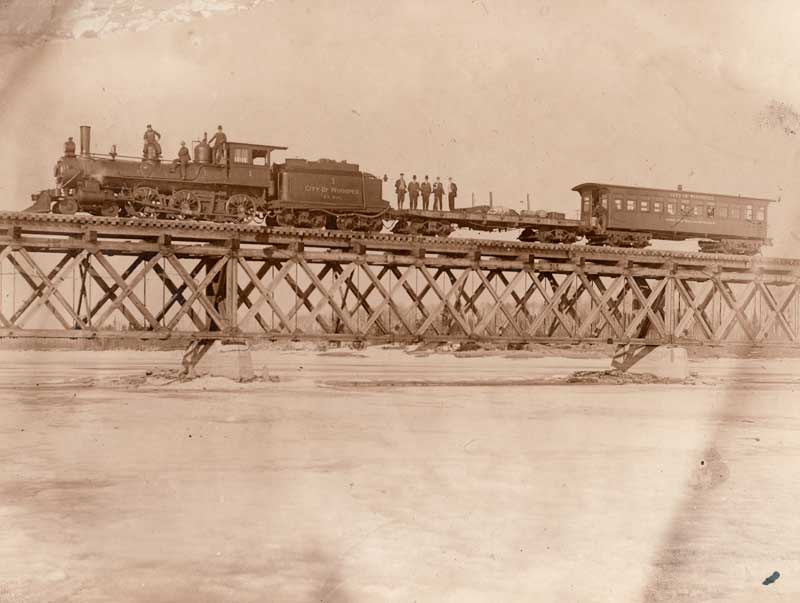Manitoba Pageant, Spring 1977, Volume 22, Number 3
|
The bridge which spans the Winnipeg River, roughly two miles north of Lac du Bonnet, gives access to the large areas of the Bird River, Lee River and Pointe du Bois. It is entirely unremarkable as bridges go but there is a far from prosaic story behind it.
The first bridge in that locality, built of timber, was constructed in 1907 to service the hydro development at Pointe du Bois. Tons of construction material rolled over it for years. Tragedy struck on 30 June 1914, when a fifty foot span gave way just as the City Hydro train was approaching the west side of the river. The engine plunged into the water and the engineer, George Wrighton, was killed. The fireman escaped injury.

City of Winnipeg, Power Construction Department train
Source: Manitoba Hydro, Pointe du Bois Album XX, page 10 (Winnipeg Hydro photos).
The loss of the bridge created very serious problems for residents of the Pointe and surrounding areas. Until the bridge was repaired, they were ferried back and forth across the river. A steam tug and scow were operated by the Winnipeg Electric Company, as well as a passenger boat capable of transporting a car or truck. The Municipality had cut a road through to the bridge from the corduroy road which led to ‘Old’ Pinawa.
In time, the bridge was repaired and the train again in service. However, because the soundness of the substructure was suspect due to vibration, policy dictated that no passengers should cross the bridge on the train.
An unusual situation now became standard practice. Planks were laid across the sleepers and when the train reached either side of the bridge, all disembarked. The engineer set the throttle and all walked across, waited for the train to catch up, whereupon everyone climbed aboard again.
Residents grew accustomed to breaking their journey with a walk across a span eight feet wide without railings over a swiftly moving water. For some Winnipeg residents, it became an ‘in’ thing to do. An account in the Winnipeg Free Press of 30 June 1958, recalls how “a sudden summer rain could make the walk very uncomfortable. Often several hundred people turned out for the City Hydro’s advertised excursions to Pointe du Bois. - The train stopped to unload at one end of the bridge and every person, save one, walked over to wait for the train. The man who stayed behind set the throttle to keep the train moving slowly, then he too got off and the train rumbled across the bridge empty. On a rainy day, the sight of all those tourists running over planks was something to see!” Sam Square, a former superintendent of the hydro plant, related how he remembers carrying his son across one morning when it was thirty below. “He was about two then and we had to get him to the doctor.”
This singular traffic problem existed for seventeen years and was responsible for many an anecdote over the years. There was a daring young man in a Model T who drove his car across the narrow structure bumping over the ties with one wheel in and one outside the tracks; many a courting couple walked over to dances at Larsen’s Point when it was too stormy to risk a boat! And then, there was the gentleman whose habit it was to spend one evening a week at the ‘pub’ and who refused to be thwarted by a risky walk. Following the habitual revelry, he crawled across on all fours when homeward bound closely attended, it must be assumed, by his guardian angel.
A new steel bridge for both rail and highway traffic was built in 1931 by the City of Winnipeg with assistance from the Federal Government, a short distance upstream from the original site. This, in present use, was raised, widened and reinforced when the level of the Winnipeg River was raised in 1952 upon completion of the dam at Powerview.
City of Winnipeg locomotive #2, 30 June 1914.
Source: Manitoba Hydro, Pointe du Bois Album #3 1912-1922 page 19 (Winnipeg Hydro photos).
City of Winnipeg locomotive #2, 30 June 1914.
Source: Manitoba Hydro, Pointe du Bois Album #3 1912-1922 page 23 (Winnipeg Hydro photos).
Page revised: 20 June 2011